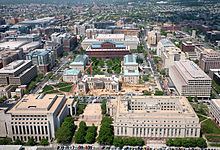 | ||
Judiciary Square is a neighborhood in Northwest Washington, D.C., the vast majority of which is occupied by various federal and municipal courthouses and office buildings. Judiciary Square is located roughly between Pennsylvania Avenue to the south, H Street to the north, 6th Street to the west, and the Interstate 395 access tunnel to the east.
Contents
- Map of Judiciary Square Washington DC 20548 USA
- Exploring the metro judiciary square elevator and courtyard
- History
- Contributing buildings
- Monuments and sculptures
- Judiciary Square Plaza
- Center Leg Freeway development
- References
Map of Judiciary Square, Washington, DC 20548, USA
The center of the neighborhood is an actual plaza named Judiciary Square. The square itself is bounded by 4th Street to east, 5th Street to the west, D Street to the south, and F Street to the north. The neighborhood is served by the Judiciary Square station on the Red Line of the Washington Metro.
Judiciary Square is also home to Georgetown University Law Center, located on New Jersey Avenue NW.
Exploring the metro judiciary square elevator and courtyard
History
During the first half of the 19th century, Judiciary Square had a heavily residential population. Its proximity to the courthouses attracted lawyers, judges, and clerks to the neighborhood, while its location between the White House and the United States Capitol made it ideal for government employees. Among its most prominent residents were Senator Thomas Hart Benton, Vice President John C. Calhoun, and Daniel Webster. As of 2006, however, nearly all of the rowhouses in the area were gone, with the remaining houses mostly centered on the intersection of 5th and D Streets.
Around the turn of the 20th century, the eastern side of Judiciary Square became an enclave of Italian immigrants in Washington; the equivalent of a Little Italy, although it was never called that. The Italian neighborhood rested on the eastern edge of the square proper, stretching eastward to about 2nd Street NW. The heart of the community was Holy Rosary Church, a chapel built at 3rd and F Streets NW. The neighborhood grew throughout the 20th century, with a particular surge of Italian immigrants in the 1950s and 60s. However, the construction of Interstate 395 through the city in the 1970s razed about half of the neighborhood and forced its remaining residents to move away from the heavy commuter traffic. Today, the former Italian enclave is dominated by Federal office buildings and law offices. The Holy Rosary Church remains standing and continues to draw a heavily Italian congregation along with its "Casa Italiana" cultural center next door.
Contributing buildings
Among the buildings in Judiciary Square are:
Monuments and sculptures
Judiciary Square Plaza
Judiciary Square Plaza is property administered by the National Park Service located between 4th and 5th Streets, NW and E and F Streets, NW. The plaza is flanked on the East and West by the District of Columbia Courts Buildings B and A respectively. Located within the grounds are the National Law Enforcement Officers Memorial and the F Street entrance to the Judiciary Square station.
Center Leg Freeway development
The District government finalized a deal in 2010 with the Louis Dreyfus Group to construct a 2,100,000-square-foot (200,000 m2) mixed-use development in the airspace over the Center Leg Freeway (Interstate 395). The $425 million office, residential, and retail project at the east end of the Judiciary Square neighborhood will also restore the area's original L'Enfant Plan street grid by reconnecting F and G Streets over the freeway. The project is awaiting final regulatory approval and is expected to be complete by 2016.
